|
THE FAIRFORD BRANCH LINE |
|
|
|
FAIRFORD |
|
Fairford station was unlike a typical branch line terminus, in that the line continued on past the station for a further ¼mile and was clearly intended as a through station in the
original plan to link up with the MSWJR at Cirencester. The standard EGR station building was provided on the single platform. This could be easily viewed from the adjacent road bridge, the site of which (SP167010) is now
the entrance to the industrial units that have obliterated all trace of the station. |
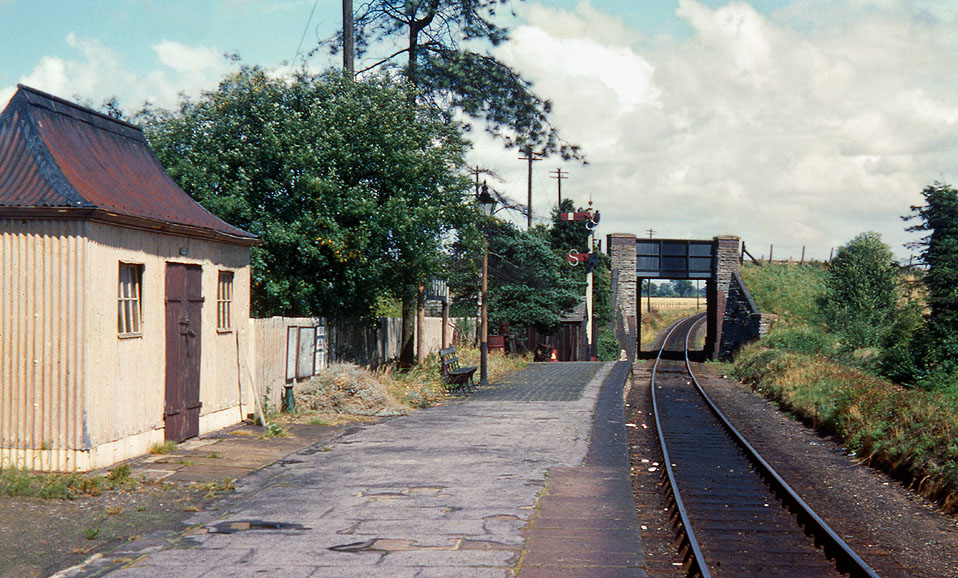 |
|
Fairford station slumbers between trains in the early 1960s. The standard GWR pagoda hut on the left
was used for bicycle storage. Note also the shunt signal below the main signal arm, the variation in the surface of the platform, and the characteristic East Gloucestershire Railway bridge with the track dipping noticeably underneath.
Kenneth Potter
|
|
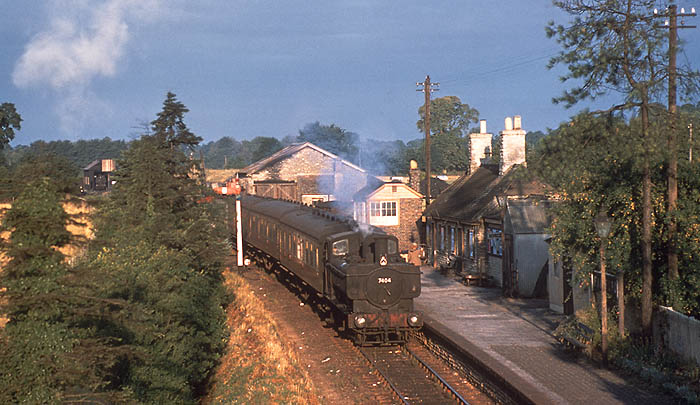
|
|
A superb panoramic picture of Fairford station in 1959. 74xx 0-6-0PT 7404 waits to depart with the 06:47 to Oxford, while just visible in the background through a gap in the trees
another pannier tank can be seen on shed. Given a pleasing perspective by the use of a telephoto lens, and in perfect early morning light, this is possibly one of the best colour views of the station.
Colour Rail (T. B. Owen)
|
|
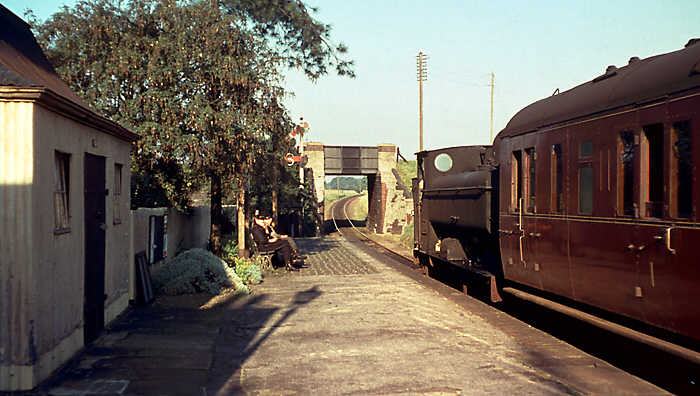
|
|
It is September 1961, and the crew of the 18:00 Fairford to Oxford train are relaxing in the warm evening sunshine before commencing their 25½ mile journey to Oxford. This
scene typifies the lazy nature of the line, no passengers visible and the signal already 'off'. The I in 100 gradient commencing under the bridge is readily apparent in this view.
Paul Strong |
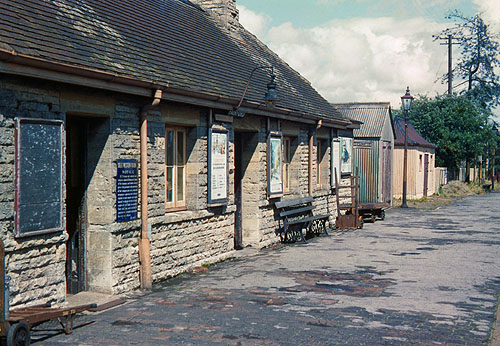 |
Like all the other East Gloucestershire Railway stations buildings (with the exception of Alvescot), Fairford station building was constructed of local stone. The glancing light clearly shows up the construction in this early 1960s view. Well over a decade since
nationalisation, there is still a Great Western Railway blue enameled notice next to the door in the foreground.
Kenneth Potter
|
|
14xx Class 0-4-2Ts were never particularly common on the Fairford Branch, possibly due to their small water capacity being ill-suited to such a long branch line. However, 1468 is
pictured here at Fairford, waiting to depart with a train for Oxford.
Colour Rail |
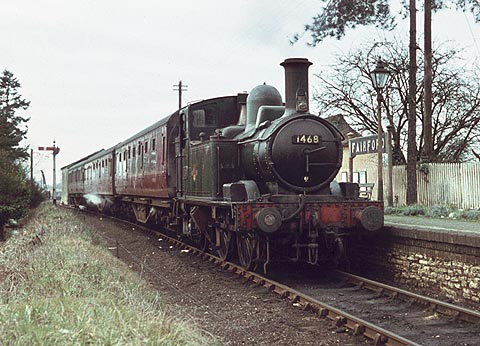
|
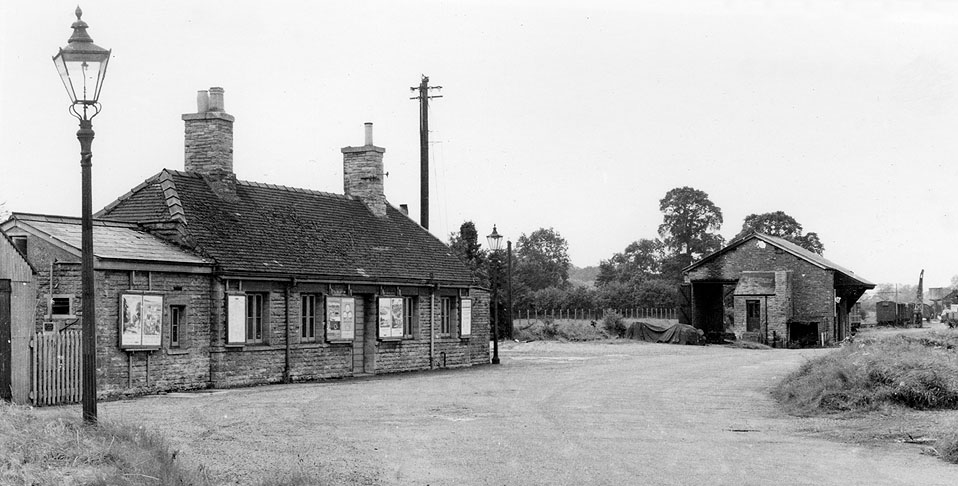 |
|
Fairford station building and goods shed, photographed in the early 1960s. Note that there is absolutely no kind of fencing or any other barrier to stop road vehicles from driving off the edge onto the line. It would all be securely fenced off nowadays, but commonsense
prevailed in the old days!
Martin Loader Collection
|
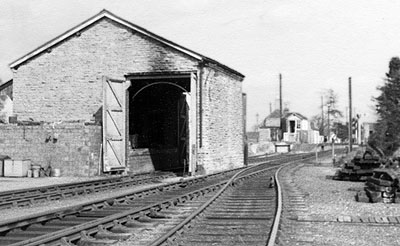 |
Fairford goods shed, pictured from the goods yard, with the station in the background. Not a very sharp picture, but I have seen surprisingly few of the shed from this angle, although as it involved trespassing on the track, perhaps that isn't quite so
surprising!
Martin Loader Collection
|
|
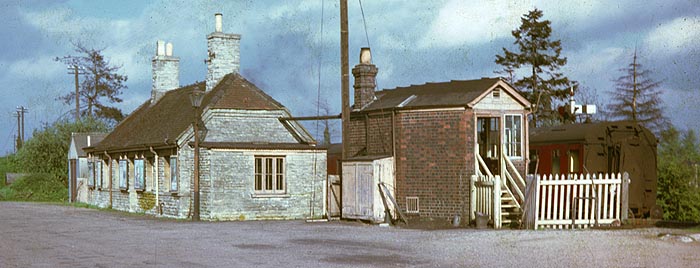
|
Despite the damage to the original slide, this view is certainly worthy of inclusion, as it shows the station building and signal box from the approach road side, in beautiful
evening light on 14 May 1962, just one month prior to closure. Note the parcels office extension on the end of the station building and the tapered rear wall of the signal box, required in order to give vehicular access
to the end loading bay.
Colour Rail |
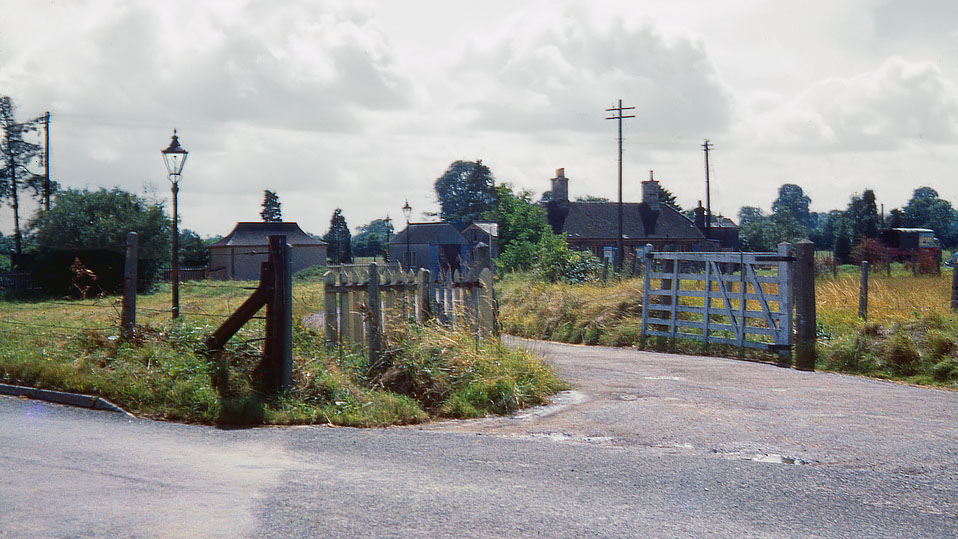 |
|
A rarely photographed
view of the road approach to Fairford station. This summer
1962 view shows the station gates, with the A417 Lechlade to
Cirencester road in the foreground.
Kenneth Potter |
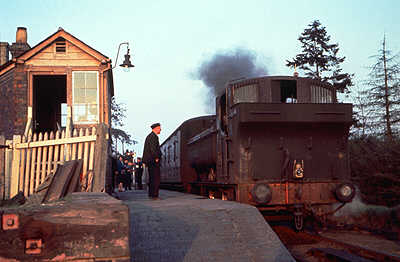 |
The last rays of the setting sun illuminate Fairford signal box and 74xx Class 0-6-0PT 7445 which has just arrived with the 16:24 service from Oxford on 25 March 1961. Unlike the
majority of branch lines, bunker first running was uncommon, full use being made of the turntable at Fairford. On this occasion however, for some reason the loco was not turned at Oxford. The photographer is standing next to
the short end unloading bay.
Gerald T. Robinson
|
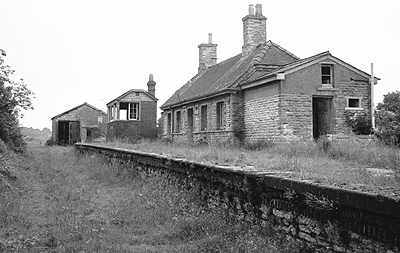 |
Pictured in the late 1960s, Fairford station is abandoned, but remarkably free from vandalism. Inspecting the original negative reveals intact glass in the signal box windows! Nearest
the camera is the toilet block, which between the wars had acquired a roof, otherwise the station building is largely unaltered. Note the odd shape of the signal box roof, a flat top to the gable end at this end, standard
gable on the other end (see above picture).
Stanley C. Jenkins
|
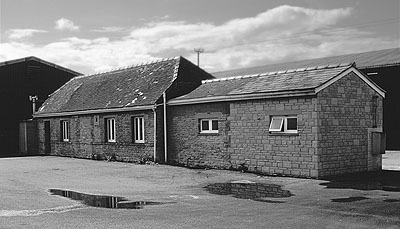 |
Fairford station building survived until the early 1990s, as it was used as
an office for a furniture company. The chimneys were removed, and the eastern extension was further extended, as this 27 May 1979 view of the building, surrounded by modern
industrial buildings, shows.
Martin Loader
|
|
|
|
There was no run-round loop in the station, instead trains proceeded towards the goods yard, where a lengthy loop was provided. The whole site was over a quarter of a mile long,
terminating in two sets of buffer stops up against an earth bank, just as if they were waiting to
extend westwards towards Cirencester. At the far end of the site a timber engine shed, turntable and standard GWR
conical water tank made up the locomotive depot, which was a sub-shed to Oxford. |
|
Three standard features of a typical branch line goods yard can be seen in this view: a hand operated crane, loading gauge and goods shed. The weeds are taking over in this early 1960s view. Close inspection of the original Kodachrome transparency
reveals a Jaguar Mk1 parked near the weighbridge hut in the background.
Kenneth Potter
|
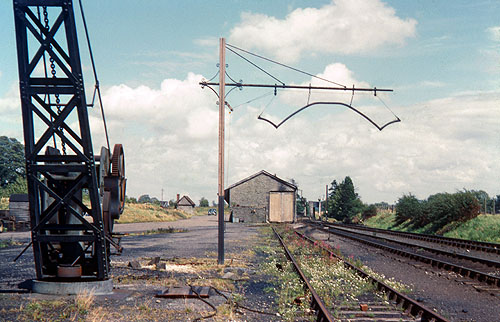 |
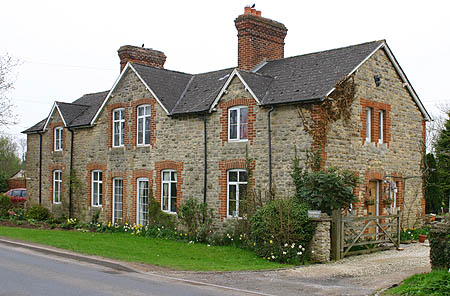 |
A pair of railway workers cottages were built near the station, on the main road towards Fairford, and are pictured here on 22 April 2006. The nearest one is named 'Terminus Cottage',
while the far one is 'Station Cottage', which nicely maintains a link with the railway, despite the fact that everything else has been swept away.
Martin Loader |
|
74xx Class 0-6-0PT 7412 (note the oil drum chimney repair) is pictured passing the goods yard, after having run round its train. Another rake of coaches can just be seen at the end of
the yard, near the water tower.
Paul Strong
|
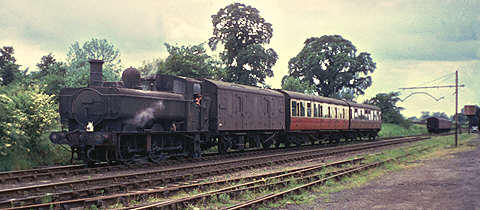 |
|
Fairford's chief claim to fame is its 15th century 'wool' church, which contains the finest collection of medieval stained glass in the country. The 28 windows containing 2,000 square
feet of coloured glass was considered so precious that it was all removed for safe storage during World War Two. Visitors arriving by train had nearly a mile to walk to the church, as once again the station was remote from
the place it was supposed to serve. When the railway opened in 1873, the pioneering Fairford Gas and Coke Company had already been trading for over twenty years, and until the mid 1930s coal was brought to for the works
was brought in by rail.
|
|
74xx Class 0-6-0PT 7404 is turned on the 55 ft turntable at Fairford on 11 June 1962. All locos were normally turned, as despite the evidence of the two pictures at the top of this
page, bunker first running was uncommon. This turntable replaced a 45 ft one on the same site.
Paul Strong |
|
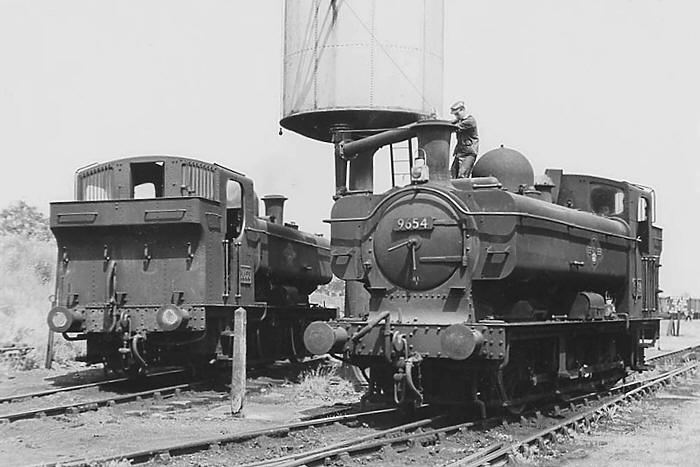
|
|
A pair of 57xx 0-6-0 pannier tanks at Fairford in June 1962. While 9654 takes water, classmate 3653 stands on the turntable road. Not an original fitting, the
water tank was
added sometime during the Great Western years.
D.K.Jones Collection |
|
The site of the turntable is visible as a circle of rougher grass in this 27 May 1979 view. The only other clue being the lamp post on the right. The picture was taken from the earth
bank that surrounded the far end of the yard (SP163008). Further concreting of the yard, and over two decades of bush growth has now obliterated this view. A public footpath passes the end of the line (approach along the
gravel road to Fairford Town Football Club), and one can stand with the remains of the railway fencing on one side of the path, and the open fields heading off towards the EGR's thwarted destination of Cirencester on the
other side.
Martin Loader
|
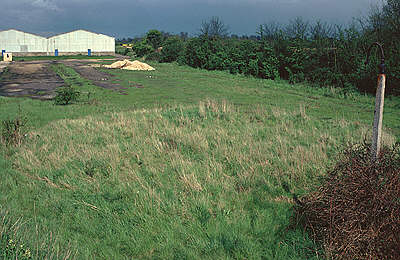
|
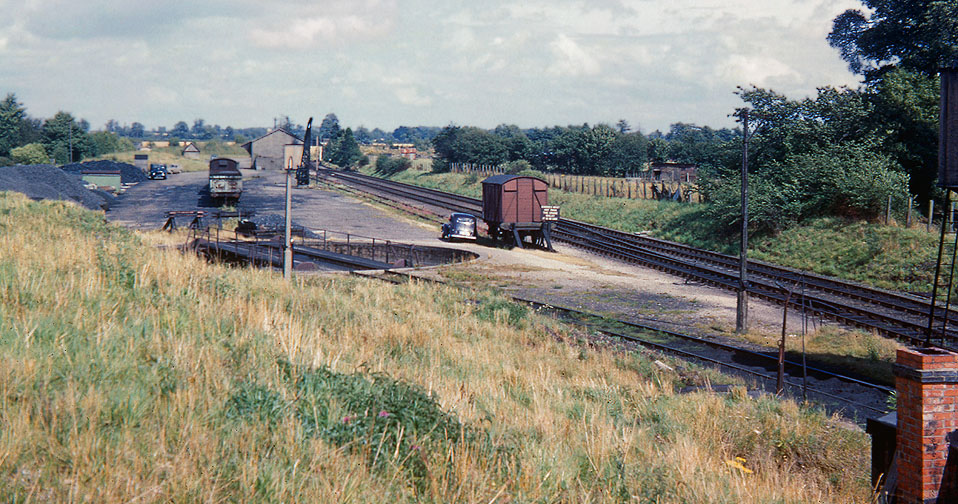 |
|
A panoramic view of the goods yard from the convenient earth bank near the loco shed. Passenger traffic at the station may have been minimal, but judging by the large piles visible on the left, coal traffic was fairly healthy.
Kenneth Potter
|
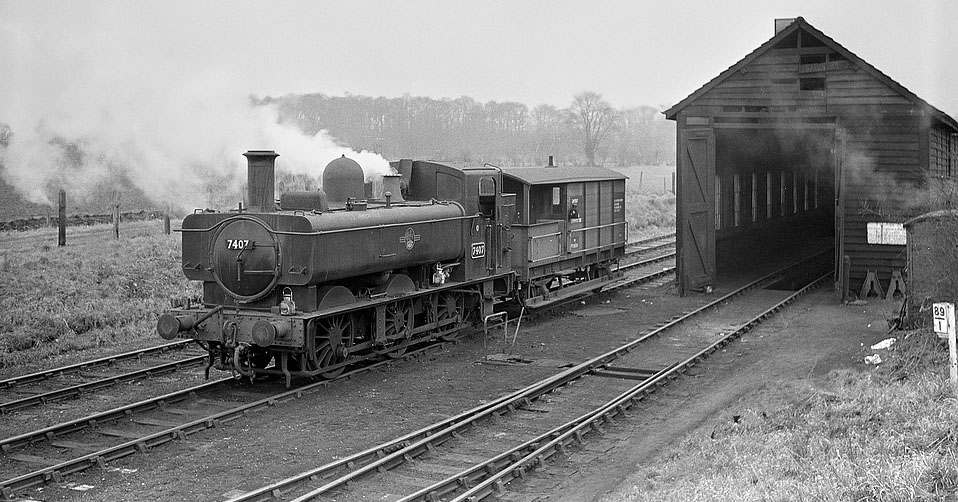
|
|
74xx 0-6-0PT 7407 and the Fairford Branch brake van stand next to the wooden loco shed on 3 March 1962. It seems that by this date a number of planks had fallen off the front of this venerable structure. Note the milepost on the right - 89¼ miles from Paddington.
Martin Loader Collection
|
|
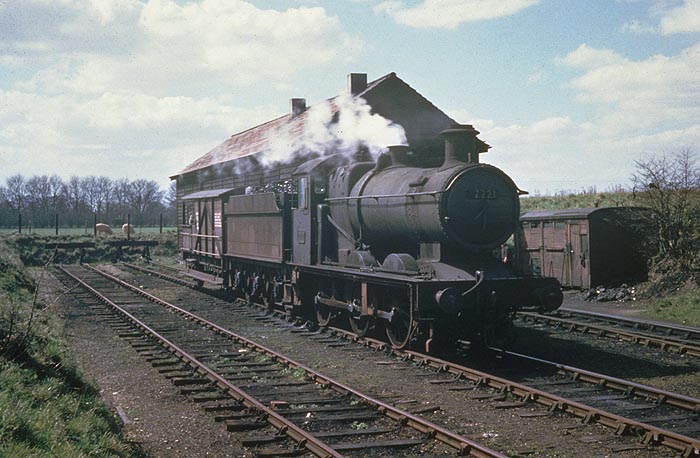
|
The very end of the line! Two pigs graze contentedly in the field through which the East Gloucestershire Railway should have continued en-route to Cirencester. 22xx 0-6-0 2221 stands
with a GWR 'Toad' brakevan in front of the timber built loco shed on 15 April 1962. The grounded horse box served as a crew mess room. The footpath mentioned above runs along the fence visible in the background.
Colour Rail |
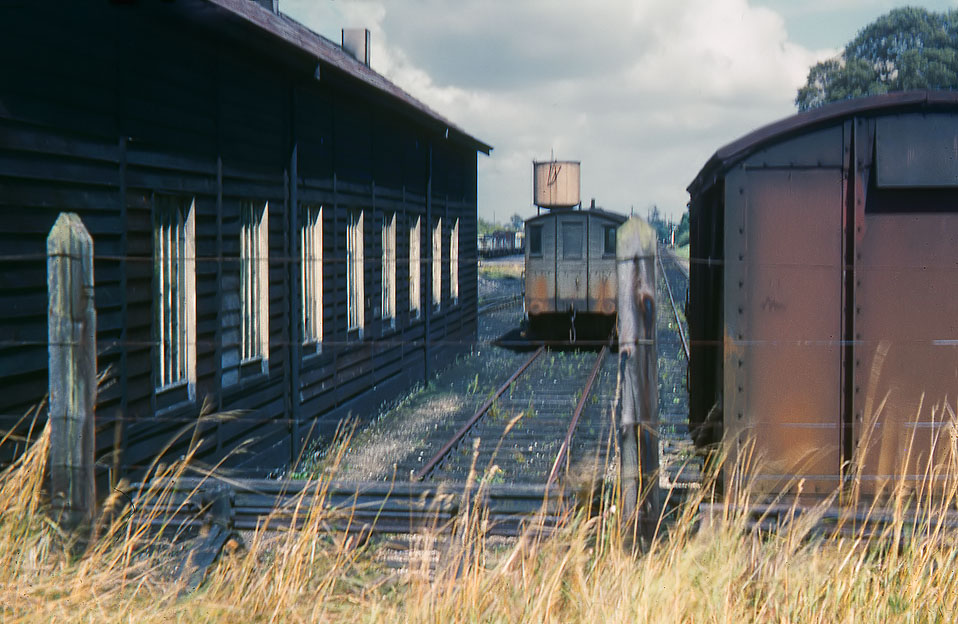 |
An unusual view of Fairford's engine shed, from the field behind the buffer stops. Note the dark colour of the ballast in the area, a mix of coal dust and ash, built up over many years.
Kenneth Potter |
|